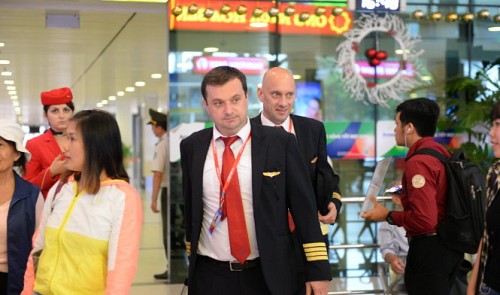While Vietnam does not appear to be hitting the breaks on its aircraft buying spree, the country’s aviation market is beginning to feel the effects of accelerated growth marred by overloaded airports, crowded airspace, and stressed flight attendants.
The Southeast Asian country’s air passenger numbers are estimated to reach 52.2 million this year, a solid 29 percent jump from 2015, according to the Civil Aviation Authority of Vietnam (CAAV).
Local airlines are rising to the occasion by leasing or buying new aircraft to meet the skyrocketing demand, a trend that is expected to continue well into 2017.
Vietnamese carriers now have a collective fleet of 147 planes, 14 more than last year, with five additional airplanes scheduled for delivery in the next two weeks.
Though the expansion is seen as positive by many in the aviation community, experts are warning of potential infrastructure failures, amongst other problems, at local airports due to rapid fleet expansion.
Vietnamese airlines currently use five airports, Noi Bai, Cat Bi, Da Nang, Cam Ranh and Tan Son Nhat, as ‘bases’ for parking aircraft overnight.
Under a development strategy for the aviation sector between 2016 and 2020, VND70 trillion (US$3.13 billion) is earmarked for infrastructure upgrades at these five airports.
Following the upgrades, the facilities are expected to collectively provide 254 aprons for overnight parking, 24 of which will be allocated to foreign carriers.
This means only 230 aprons will be available for local carriers with an expected combined fleet of 263 planes altogether by 2020.
With airport infrastructure lagging behind the rapid growth of air passenger numbers, flight delays and cancelations are something common for air travelers in Vietnam.
The flight attendants, it turns out, also suffer from intense pressure brought about by busier schedules which accompany new routes and additional flights launched by airlines to meet rising demands.
An air hostess who works for a major airline told Tuoi Tre (Youth) newspaper that she and her coworkers each have 118 days off per year, but few are able to use them due to busy schedules.
The carrier recently decided to convert unspent days off into cash allowances, she added on condition of anonymity.
Even when flight attendants are allowed to rest between flights, the break is too short to ensure their health, according to the air hostess.
“It is stipulated that attendants rest at least 11 hours between two flights, and most of the time we are only able to enjoy that minimum break time, which is not good for our long-term health” she said.

























































